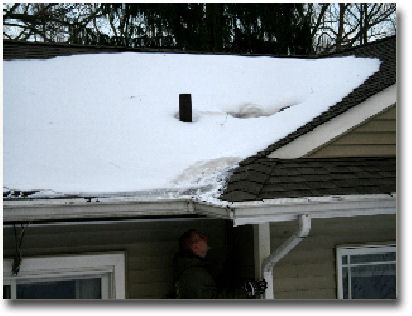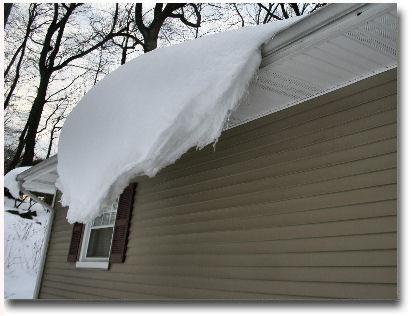PROPER
VENTILATION PREVENTS ICE DAMS (Please
be patient - This Presentation will take a moment
to load)
As Ice Dams on top of the roof, Mold may be growing in the attic.
SEE OUR ICE DAM ANSWERS INTERACTIVE
Downloadable
Adobe *.PDF - Book from Air Vent, Inc. that started
a revolution: Principles
of Attic Ventilation
ICE
& WATER UNDERLAY IS NOT THE ANSWER

Sometimes, however, proper
ventilation is very hard to achieve and circumstances
necessitate powerful measures to guarantee results.
Click on the image to visit this job
photo page which includes graphic examples of
haphazard attempts at repair and the damage incurred
over a 15+ year struggle with unknowledgeable contractors
and the leaks caused by the wrong approach.
|
|
| FIRST - START WITH THE OBVIOUS! |
| Ask an expert and gain valuable knowledge. |
 |
The image above is from a job in progress where an insulation contractor installed blown insulation without a vapor barrier, nor did he he even care about the fact that there was inadequate ventilation. Result: Moisture in the Attic! We installed the proper ventilation and suggested a vapor barrier that would resolve the issues, but we found an ice dam in the rear caused by a bathroom ventilator that exhausted into a snow drift that froze and blocked roof drainage. |

|
| The image above is an ice dam forming on a home that has very little attic insulation. A "hot-spot" causes irregular melting of the snow and the "bridge effect" caused the freezing on the edge. A subsequent rain or snow event could be devastating with influxes of water that could ruin the interior of the home. **Note the "bridge effect" is the unventilated roof edge that is colder than the attic, similar to bridge on a roadway that freezes before the road over land. |
|
|
Occasionally,
there are circumstances where we must get proactive
in our preventative measures to ensure that ice
and snow dams at eave’s edge will not create
blockages to the melting precipitation. To the left
is just one of those situations. With zero intake
ventilation available, this was a troubled hot spot
on the roof. Ice and snow would melt very easily
from this roof area because of the relative “dead”
attic beneath it that supplied continuous warmth
to the area. The problem arose every year as the
melting precipitation met the cold scupper box and
froze almost instantly. The ensuing blockage at
roof’s eave would grow to exceed the roof
slope and the influx of water was devastating.
Solution:
Electric Thermostatically Controlled, Hard Wired,
Ice and Snow Melt System that prevents ice dams.
|